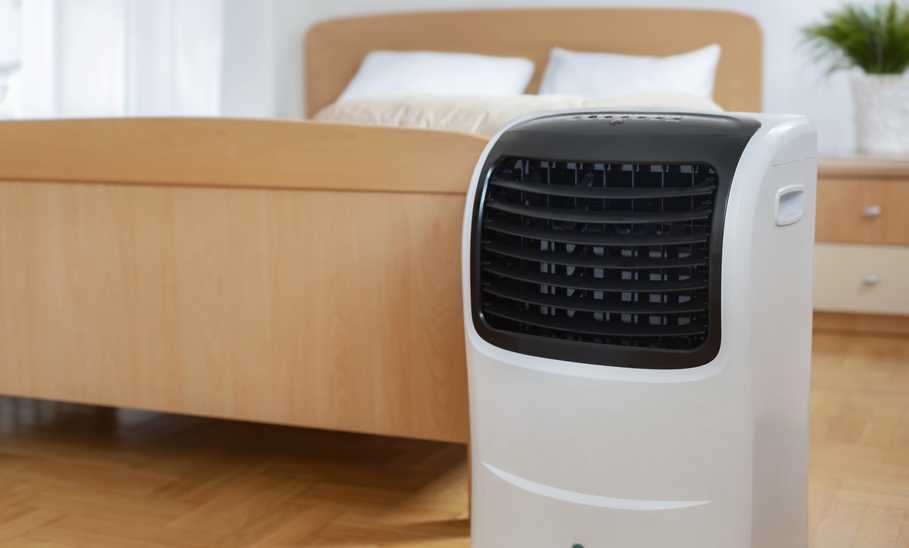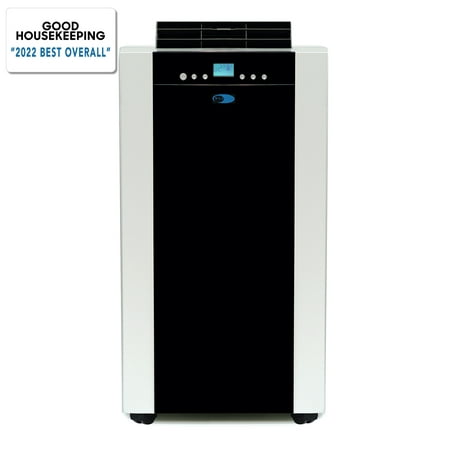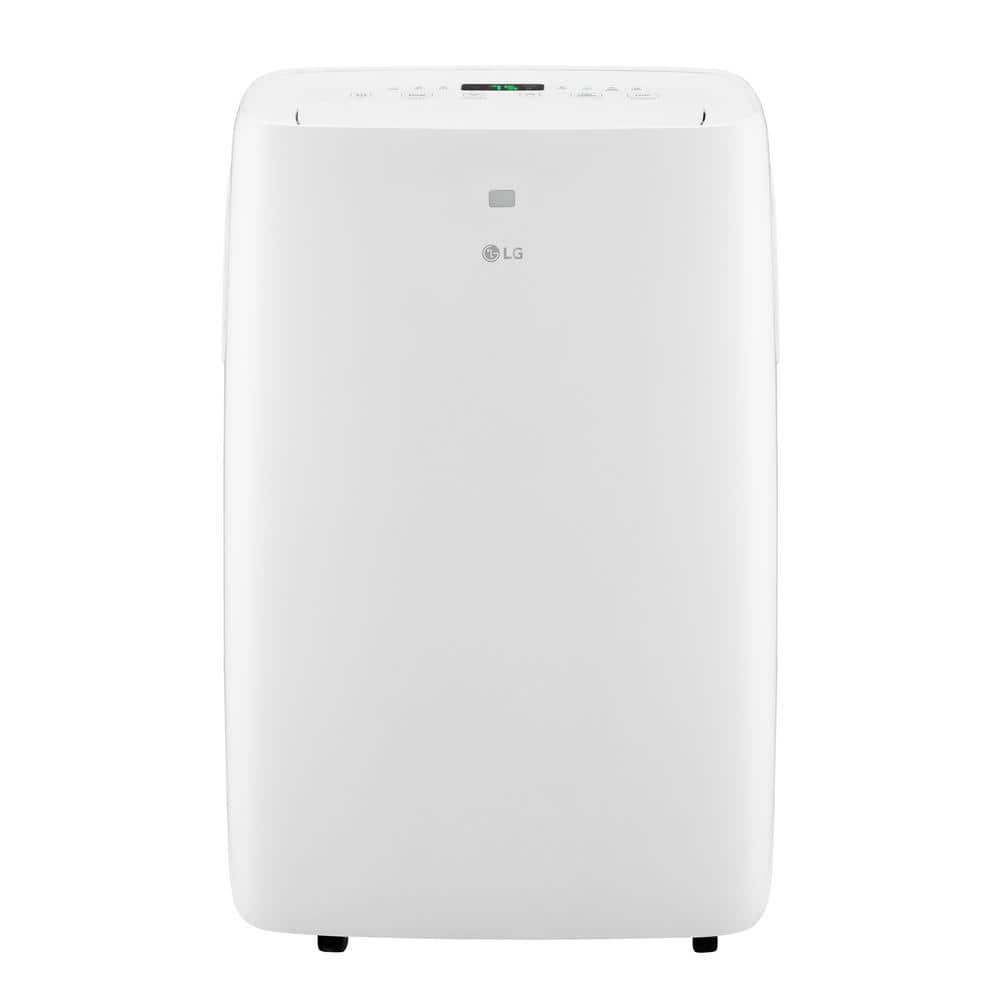- Cooling area: Up to 500 square feet
- Cooling capacity: 14,000 BTUs
- Weight: 73 pounds
- CEER: 7.69
- Dimensions: 16 x 19 x 35.5 inches
- Type: Dual-hose
- Price on publish: $529.99
Best Portable Air Conditioners, According to an HVAC Expert

Our evaluations and opinions are not influenced by our advertising relationships, but we may earn a commission from our partners’ links. This content is created by TIME Stamped, under TIME’s direction and produced in accordance with TIME’s editorial guidelines and overseen by TIME’s editorial staff. Learn more about it.
Whether you live in an area with a warmer climate year-round and are looking to supplement an existing ceiling fan or central air system, or are looking for a standalone air conditioning unit, a portable air conditioner can help. “Portable air conditioning units can easily be moved from room to room and do not look unsightly as a window unit sticking out the window,” says Chris Walters, HVAC expert, holder of Class A license in air conditioning and refrigeration in Texas, and owner of The Training Center of Air Conditioning & Heating based in Houston, Texas. “There are various reasons to choose portable air conditioning units with the main reasons being the ability to economically cool only one space, avoid HOA restrictions on window units, or spot-cool a particular area.”
To find the best portable air conditioners on the market, we chatted with Watlers about factors people should consider when shopping for a portable air conditioner including cooling capability, features, and energy efficiency. We also asked him for his portable air conditioner recommendations to complement the list of those we compiled via online research after examining product information and customer reviews.

For a portable air conditioner that checks the boxes, consider the Whynter Dual-Hose Portable Air Conditioner. With the ability to cool areas of up to 500 square feet, it’s a great fit for a variety of room sizes and cools using 14,000 BTUs of energy. That said, its CEER is 7.69 and it is simple to set up and adjust the thermostat. It is expensive, but does include patented auto-drain technology and has an exhaust hose that can be expanded up to 60 inches, which is longer than that of many other similar portable air conditioners.
Although this portable air conditioner is $600, it has many convenient and efficient features including an expandable exhaust hose, an easily adjustable thermostat, and a simple setup process.

If you’re looking for a portable air conditioner that won’t break the bank, consider adding this one from Shinco to your cart. For under $300, this single-hose portable air conditioner can cool areas up to 200 square feet and is lightweight at 46.30 pounds making it easy to move around. It also has three modes (air conditioner, dehumidifier, and fan) which you can toggle between. And, this portable air conditioner, which can be adjusted to temperatures between 60° Fahrenheit to 86° Fahrenheit, doesn’t require any tools for assembly, so you can attach the hose to a window within minutes.
For under $300, this portable air conditioner is a solid choice for those wanting an affordable gadget that is easy to install and equipped with several features.

Although many portable air conditioners on the market today are made with technology to reduce their noise levels, not many are as quiet as this portable air conditioner from De’Longhi. Thanks to its specially engineered design, this machine operates at 53 decibels which can be equated to the noise of a quiet refrigerator. Along with its quiet air, this portable air conditioner promotes cleanliness via its washable filter and conservation with its timer that can be adjusted as needed. If you need to transport it from room to room, keep in mind that it weighs 83.3 pounds.
Emitting only 53 decibels of sound, this portable air conditioner from De’Longhi is a great option for those who don’t want to have to worry about their new gadget being too loud when in use.

For a portable air conditioner with great value, Walters recommends Cooper & Hunter’s Inverter Portable Air Conditioner. “This unit has all the bells and whistles with top-of-the-line inverter technology, dual hoses, dehumidifier options, and an easy-to-clean filter,” he says. It can cool up to 550 square feet making it suitable for small, medium, and larger-sized rooms.
Make sure to note that this unit is heavier than many other of our picks weighing in at nearly 85 pounds. However, despite its larger size, this portable air conditioner only produces 42 decibels of sound regardless of whether or not it cools or heats a room (as it can produce air with a temperature of up to 95° Fahrenheit). Plus, its matte finish will elevate whichever space you decide to place it.

If you’re looking to cool a small room, Walters recommends this portable air conditioner from LG. “Small rooms need small units that typically lack some bigger unit features like dual hoses and inverter. However, this unit will get the job done in a small room,” he says. It’s designed to cool areas up to 250 square feet and does so using 6,000 BTUs while maintaining a high CEER of 11.
Even though it’s made to cool smaller rooms, it doesn’t lack when it comes to features as it’s equipped with a remote control which includes batteries, a 59-inch power cord, two fan speeds, and an air vent that moves to evenly circulate air. You’ll also be able to tell when it’s time to clean out the filter thanks to its filter light which is beneficial considering the device does not have an automatic shut-off feature.

This single-hose portable air conditioner from Black + Decker with a cooling capacity of 14,000 BTUs is designed to cool large rooms up to 700 square feet. In addition to its impressive cooling capabilities, this portable air conditioner has side handles that can be pulled to easily transport it from between rooms and a top LED display containing the vital settings and output information you may want to keep track of while using it. Plus, it’s made with an environmentally friendly refrigerant.

It’s hard to go wrong with a smart portable air conditioner, but most especially this four-in-one smart air conditioner from GE Appliances which Walters recommends. “If wireless control from your smartphone is a desired feature, this unit provides that feature and it has a mid to large room capability,” he shares. What makes this smart air conditioner stand out is its ability to be controlled by its corresponding app via its built-in WiFi. You can program your gadget to reach your desired temperature when you get home or if you have guests over who may not be the most tech-savvy. Although you don’t have to connect a second hose to this portable air conditioner, it is compatible and helps expedite the cooling process—either way, this machine will work to cool, heat, dehumidify, or circulate air according to your needs.

As far as dual-hose portable air conditioners go, Walters recommends the Midea Duo High-Efficiency Inverter Ultra Quiet Portable Air Conditioner. “When it comes to dual hose units, this one checks all the boxes: dual hose, inverter technology, and is ultra-quiet. It also works with Alexa and Google Assistant.” It is an investment with a higher price tag of just under $700, though, so make sure your budget would grant your purchase before hitting that “buy now” button.

This portable air conditioner from Costway can essentially be customized any way you please. Whether you like to keep your fan speed on ‘high’ or ‘low,’ you can do that with the touch of a button using its touch panel or remote control. Although it's a tiny detail, you can alter the blades through which the air passes to sit vertically or horizontally. Plus, this gadget is so sleek, it can fit in a plethora of locations and even comes with wheels and a handle for a hassle-free transport experience.

Although it’s not technically an air conditioner and doesn't contain a refrigerant, the Honeywell 500 CFM Indoor Portable Evaporative Cooler works similarly to cool spaces up to 300 square feet. Although it does require ice, it will alarm you when water is running low and can even be set to perform for a specific period if you’re looking to conserve some energy. However, if you opt to keep your machine in “sleep” mode, it works differently than that of many other gadgets which may be confusing to some. Regardless of whether or not you use this freestanding machine during the day or while sleeping, you’ll notice the humidity decrease—and I think that is pretty cool.
The point of purchasing a portable air conditioner is to cool your home or wherever you wish to cool. That said, it’s important to be knowledgeable about how their cooling capacity is denoted by BTUs (British Thermal Units). Walters notes that most portable air conditioners commonly have a cooling capacity between 7000 and 1400 BTUs. However, some may have a capacity that deviates slightly from this range. “Be mindful that bigger units require more power,” says Walters. “Manufacturers typically give a room size that can be cooled listed in square footage—this is a maximum room size, so keep that in mind.”
As far as what features to look for when shopping for a portable air conditioner, you’ll want to look for one that is easy to operate. The last thing you’re going to want to do when you spend a lot of money on a new gadget is to wonder about whether or not you’re going to break it by pressing the wrong button or shifting a piece that isn’t supposed to be moved out of place. LED display screens are great so you can easily make decisions during the night or if you’re in the dark. An extendable extension cord and/or hose is also beneficial if you don’t have access to an extension power cord or have a window that is further back. If you’re someone who values a personalized cooling experience, look for those that offer a variety of fan speeds and settings.
Many portable air conditioners also serve as dehumidifiers, so make sure to take note of that, too. If conservation is important to you, opt for a portable air conditioner with an environmentally friendly refrigerant. The features you’ll find in a portable air conditioner will vary depending on the air conditioner brands you consider.
When considering portable air conditioners, you’re going to ideally want to choose one that is energy efficient (or at least is somewhat energy efficient). “Portable air conditioning units are rated in CEER (Combined Energy Efficiency Ratio),” explains Walters. ”The higher the number the more efficient it is.” You’ll notice that many portable air conditioners have CEER ratings between 6.0 and 15. The CEER measurement is calculated by taking the amount of a portable air conditioner’s BTUs per hour and dividing that total by the amount of electrical energy inputted denoted by watts (W).
Both single-hose and dual-hose portable air conditioners have their pros and cons. Walters notes that single-hose portable air conditioners will act more like spot coolers. However, he adds that dual-hose portable air conditioners better help to maintain a room balance.
Although they are similar, portable air conditioners and window units both have pros and cons that should be considered before deciding which is best for you. Portable air conditioners may be more aesthetically pleasing than window units because they do not stick outside of a window. Walters notes that this may be particularly favorable, especially for those who live in HOA communities with regulations against window units. On the other hand, Walters explains that window air conditioner units may work more seamlessly and without exhaust and drain issues since the water produced from condensation simply drips outside.
To create my list of the best portable air conditioners, I spoke with an HVAC expert about what factors to consider when shopping, including cooling capabilities, features, and energy efficiency. Additionally, I conducted online research to complement our expert picks based on product information and reviews.
The cost will depend on the type of portable air conditioner you’re interested in and the brand. However, Walters notes that most portable air conditioners come with a price tag within the $300 to $700 range. “The more expensive models are inverter type and have the quietest operation and ability to ramp up and down as needed versus on or off.” Although a price tag of $300 to $700 is common for most portable air conditioners, you may find some on the market for a couple of hundred dollars, more or less.
A portable air cooler/conditioner can be an effective appliance. However, Walters advises that one needs to ensure they are purchasing the right size to match the space where they intend to use it. “Because they [portable air coolers/conditioners] plug into existing wall outlets, they are more limited in size than a window unit,” he explains. “Typically, 14000 BTUs is the largest size available [which is] enough for most single rooms.” He adds that most portable air conditioners are not designed to cool multiple rooms.
According to Walters, the best place to put a portable air conditioner is near a window as that is where the exhaust hoses need to be connected. Since most hoses on a portable air conditioning unit are only a couple of feet in length, he advises connecting a hose to the window within a couple of feet of a unit’s exhaust port.
Portable air conditioners do not need a water supply. That said, “they create several gallons of water during operation that must be sent out the exhaust hose,” says Walters. When it comes to vents, Walters notes that it is important to ensure that the vent of your portable air conditioner faces the outside to work properly.
The information presented here is created by TIME Stamped and overseen by TIME editorial staff. To learn more, see our About Us page.



